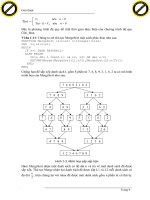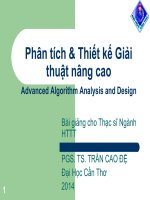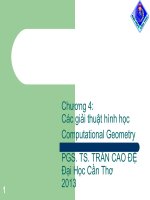Slide phân tích và thiết kế giải thuật chap8 approximation algorithms
Bạn đang xem bản rút gọn của tài liệu. Xem và tải ngay bản đầy đủ của tài liệu tại đây (378.79 KB, 29 trang )
.c
om
ng
th
an
co
ng
Chapter 8
cu
u
du
o
Approximation Algorithms
1
CuuDuongThanCong.com
/>
ng
co
an
th
ng
du
o
u
Why approximation algorithms?
The vertex cover problem
The set cover problem
TSP
Scheduling Independent tasks
Bin packing
cu
.c
om
Outline
2
CuuDuongThanCong.com
/>
Why Approximation Algorithms ?
.c
om
ng
u
cu
du
o
ng
th
an
Many problems of practical significance are NPcomplete but are too important to abandon merely
because obtaining an optimal solution is intractable.
If a problem is NP-complete, we are unlikely to find
a polynomial time algorithm for solving it exactly, but
it may still be possible to find near-optimal solution
in polynomial time.
In practice, near-optimality is often good enough.
An algorithm that returns near-optimal solutions is
called an approximation algorithm.
co
3
CuuDuongThanCong.com
/>
Performance bounds for approximation
algorithms
.c
om
du
o
u
cu
ng
th
ng
co
i is an optimization problem instance
c(i) be the cost of solution produced by approximate
algorithm and c*(i) be the cost of optimal solution.
For minimization problem, we want c(i)/c*(i) to be as
small as possible.
For maximization problem, we want c*(i)/c(i) to be as
small as possible.
An approximation algorithm for the given problem
instance i, has a ratio bound of p(n) if for any input of
size n, the cost c of the solution produced by the
approximation algorithm is within a factor of p(n) of the
cost c* of an optimal solution. That is
max(c(i)/c*(i), c*(i)/c(i)) ≤ p(n)
an
4
CuuDuongThanCong.com
/>
.c
om
ng
co
an
We define the relative error of the approximate algorithm
for any input size as
|c(i) - c*(i)|/ c*(i)
We say that an approximate algorithm has a relative error
bound of ε(n) if
|c(i)-c*(i)|/c*(i)≤ ε(n)
th
ng
du
o
u
Note that p(n) is always greater than or equal to 1.
If p(n) = 1 then the approximate algorithm is an
optimal algorithm.
The larger p(n), the worst algorithm
Relative error
cu
5
CuuDuongThanCong.com
/>
Vertex cover: given an undirected graph
G=(V,E), then a subset V'⊆V such that if
∀(u,v)∈E, then u∈V' or v ∈V' (or both).
Size of a vertex cover: the number of vertices
in it.
Vertex-cover problem: find a vertex-cover of
minimal size.
This problem is NP-complete
du
o
u
cu
ng
th
an
co
ng
.c
om
1. The Vertex-Cover Problem
6
CuuDuongThanCong.com
/>
.c
om
Approximate vertex-cover algorithm
cu
u
du
o
ng
th
an
co
ng
APPROX-VERTEX-COVER(G)
1. C ← ∅
2. E ← E[G]
3. while E ≠ ∅ do
4. let (u,v) be an arbitrary edge of E
5. C ← C ∪ {u,v}
6. remove from E every edge incident on either u or v
7. return
The running time of this algorithm is O(E).
7
CuuDuongThanCong.com
/>
.c
om
ng
co
an
th
ng
du
o
u
cu
8
CuuDuongThanCong.com
/>
Theorem:
APPROXIMATE-VERTEX-COVER has a ratio
bound of 2, i.e., the size of returned vertex cover
set is at most twice of the size of optimal vertexcover.
Proof:
co
an
th
ng
du
o
It runs in poly time
The returned C is a vertex-cover.
Let A be the set of edges picked in line 4 and C*
be the optimal vertex-cover.
Then C* must include at least one end of each edge in A
and no two edges in A are covered by the same vertex
in C*, so |C*|≥|A|.
Moreover, |C|=2|A|, so |C|≤2|C*|.
u
cu
ng
.c
om
9
CuuDuongThanCong.com
/>
The Set Covering Problem
.c
om
The set covering problem is an optimization problem that models
many resource-selection problems.
An instance (X, F) of the set-covering problem consists of a finite
set X and a family F of subsets of X, such that every element of
X belongs to at least one subset in F:
ng
an
co
X =∪S
th
S∈F
ng
cu
S∈C
u
X =∪S
du
o
We say that a subset S∈F covers its elements.
The problem is to find a minimum-size subset C ⊆ F whose
members cover all of X:
We say that any C satisfying the above equation covers X.
10
CuuDuongThanCong.com
/>
.c
om
ng
co
an
th
ng
du
o
u
cu
Figure 6.2 An instance {X, F} of the set covering problem, where X
consists of the 12 black points and F = { S1, S2, S3, S4, S5, S6}. A
minimum size set cover is C = { S3, S4, S5}. The greedy algorithm
produces the set C’ = {S1, S4, S5, S3} in order.
CuuDuongThanCong.com
/>
11
Assume that X is a set of skills that are needed to
solve a problem and we have a set of people
available to work on it. We wish to form a team,
containing as few people as possible, s.t. for every
requisite skill in X, there is a member in the team
having that skill.
Assign emergency stations (fire stations) in a city.
Allocate sale branch offices for a company.
Schedule for bus drivers.
du
o
u
cu
ng
th
an
co
ng
.c
om
Applications of Set-covering problem
12
CuuDuongThanCong.com
/>
An Example: Fire stations
cu
u
du
o
ng
th
an
co
ng
.c
om
S1 = {x1, x2, x3, x4}
S2 = { x1, x2, x3, x4, x5}
S3 = { x1, x2, x3, x4, x5, x6}
S4 = { x1, x3, x4, x6, x7}
S5 = { x2, x3, x5, x6, x8, x9}
S6 = { x3, x4, x5, x6, x7, x8}
S7 = { x4, x6, x7, x8 }
S8 = { x5, x6, x7, x8, x9, x10}
S9 = { x5, x8, x9, x10, x11}
S10 = { x8, x9, x10, x11}
S11 = { x9, x10, x11}
The optimal solution:
S = {S3, S8, S9}
The map of a city
13
CuuDuongThanCong.com
/>
A greedy approximation algorithm
ng
th
an
co
ng
.c
om
Greedy-Set-Cover(X, F)
1. U = X
2. C = ∅
3. while U != ∅ do
4.
select an S∈F that maximizes | S ∩ U|
5.
U=U–S
6.
C = C ∪ {S}
7. return C
cu
u
du
o
The algorithm GREEDY-SET-COVER can easily be
implemented to run in time complexity in |X| and |F|. Since the
number of iterations of the loop on line 3-6 is at most min(|X|,
|F|) and the loop body can be implemented to run in time
O(|X|.|F|), there is an implementation that runs in time
O(|X|.|F|.min(|X|,|F|)) .
14
CuuDuongThanCong.com
/>
.c
om
Ratio bound of Greedy-set-cover
Let denote the dth harmonic number
ng
d
an
th
Theorem: Greedy-set-cover has a ratio bound
H(max{|S|: S ∈F})
Corollary: Greedy-set-cover has a ratio bound of
(ln|X| +1)
(Refer to the text book for the proofs)
u
cu
du
o
ng
co
Hd = Σi-11/i
15
CuuDuongThanCong.com
/>
3. The Traveling Salesman Problem
Since finding the shortest tour for TSP requires so
much computation, we may consider to find a tour
that is almost as short as the shortest. That is, it
may be possible to find near-optimal solution.
Example: We can use an approximation algorithm
for the HCP. It's relatively easy to find a tour that is
longer by at most a factor of two than the optimal
tour. The method is based on
u
the algorithm for finding the minimum spanning tree and
an observation that it is always cheapest to go directly from
a vertex u to a vertex w; going by way of any intermediate
stop v can’t be less expensive.
C(u,w) ≤ C(u,v)+ C(v,w)
cu
du
o
ng
th
an
co
ng
.c
om
16
CuuDuongThanCong.com
/>
APPROX-TSP-TOUR
The algorithm computes a near-optimal tour of an
undirected graph G.
procedure APPROX-TSP-TOUR(G, c);
begin
select a vertex r ∈ V[G] to be the “root” vertex;
grow a minimum spanning tree T for G from root r, using
Prim’s algorithm;
apply a preorder tree walk of T and let L be the list of
vertices visited in the walk;
form the Halmintonian cycle H that visits the vertices in
the order of L.
/* H is the result to return * /
end
A preorder tree walk recursively visits every vertex in the
tree, listing a vertex when its first encountered, before
any of its children are visited.
cu
u
du
o
ng
th
an
co
ng
.c
om
17
CuuDuongThanCong.com
/>
cu
u
du
o
ng
th
an
co
ng
.c
om
Thí dụ minh họa giải thuật APPROX-TSP-TOUR
18
CuuDuongThanCong.com
/>
.c
om
ng
co
an
th
ng
du
o
cu
u
The preorder tree walk is not simple tour, since a node be visited many
times, but it can be fixed, the tree walk visits the vertices in the order a,
b, c, b, h, b, a, d, e, f, e, g, e, d, a. From this order, we can arrive to the
hamiltonian cycle H: a, b, c, h, d, e ,f, g, a.
19
CuuDuongThanCong.com
/>
co
ng
.c
om
The optimal tour
u
du
o
ng
th
an
The total cost of H is
approximately 19.074. An
optimal tour H* has the total
cost of approximately 14.715.
cu
The running time of APPROX-TSP-TOUR is the running
time of the Prim algorithm. If the graph is implemented by
adjacency matrix, it’s O(V2lgV)≈ O(E.lgV) since the input
graph is a complete graph.
20
CuuDuongThanCong.com
/>
Ratio bound of APPROX-TSP-TOUR
.c
om
Proof: Let H* be an optimal tour for a given set of
vertices. Since we obtain a spanning tree by deleting
any edge from a tour, if T is a minimum spanning tree
for the given set of vertices, then
c(T) ≤ c(H*)
(1)
A full walk of T traverses every edge of T twice, we
have:
c(W) = 2c(T)
(2)
(1) and (2) imply that:
c(W) ≤ 2c(H*)
(3)
du
o
u
cu
ng
th
an
co
Theorem: APPROX-TSP-TOUR is an approximation algorithm with a ratio bound of 2 for the TSP
with triangle inequality.
ng
21
CuuDuongThanCong.com
/>
But W is not a tour, since it visits some vertices more
than once. By the triangle inequality, we can delete a
visit to any vertex from W. By repeatedly applying this
operation, we can remove from W all but the first visit to
each vertex.
Let H be the cycle corresponding to this preorder walk. It
is a hamiltonian cycle, since every vertex is visited
exactly once. Since H is obtained by deleting vertices
from W, we have
c(H) ≤ c(W)
(4)
From (3) and (4), we conclude:
c(H) ≤ 2c(H*)
So, APPROX-TSP-TOUR returns a tour whose cost is not
more than twice the cost of an optimal tour.
cu
u
du
o
ng
th
an
co
ng
.c
om
22
CuuDuongThanCong.com
/>
Scheduling independent tasks
.c
om
ng
du
o
u
cu
ng
th
co
An instance of the scheduling problem is defined by a
set of n task times, ti, 1≤ i ≤ n, and m, the number of
processors.
Obtaining minimum finish time schedules is NPcomplete.
The scheduling rule we will use is called the LPT
(longest processing time) rule.
Definition: An LPT schedule is one that is the result of
an algorithm, which, whenever a processor becomes
free, assigns to that processor a task whose time is the
largest of those tasks not yet assigned.
an
23
CuuDuongThanCong.com
/>
Example
Let m = 3, n = 6 and (t1, t2, t3, t4, t5, t6) = (8, 7, 6, 5,
4, 3). In an LPT schedule tasks 1, 2 and 3
respectively. Tasks 1, 2, and 3 are assigned to
processors 1, 2 and 3. Tasks 4, 5 and 6 are
respectively assigned to the processors 3, 2, and 1.
The finish time is 11. Since Σ ti /3 = 11, the schedule
is also optimal.
an
th
ng
P3
P3
u
P1
du
o
678
cu
co
ng
.c
om
11
1
6
2
5
3
4
24
CuuDuongThanCong.com
/>
Example
Let m = 3, n = 6 and (t1, t2, t3, t4, t5, t6, t7) = (5, 5, 4,
4, 3, 3, 3). The LPT schedule is shown in the
following figure. This has a finish time is 11. The
optimal schedule is 9. Hence, for this instance |F*(I)
– F(I)|/F*(I) = (11-9)/9=2/9.
5
P2
2
P3
3
6
7
u
1
11
cu
P1
8
du
o
4 5
ng
th
an
co
ng
.c
om
4
(a) LPT schedule
9
1
3
2
4
5
6
7
(b) Optimal schedule
25
CuuDuongThanCong.com
/>









